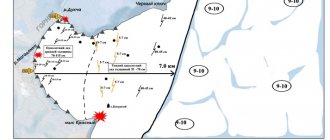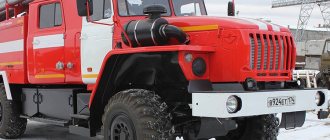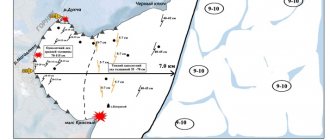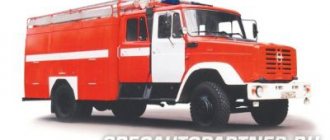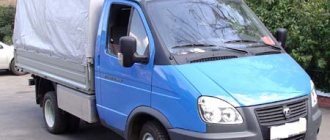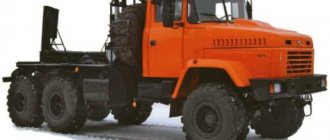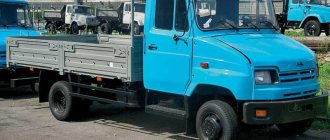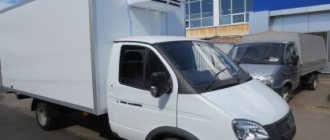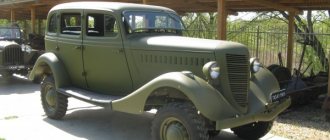05.06.2019
Automotive tanks (AT) based on domestic vehicles are equipped with powerful pumps to ensure water supply to the fire site within the estimated time. How many tons of water in a fire truck depends on the type of AC, which is selected based on the requirements of the specific customer of the vehicle. ATs based on domestic vehicles of the ZIL, KAMAZ, GAZ, URAL brands have been adapted to Russian operating conditions, demonstrating good performance in real fire extinguishing situations.
Characteristics
Technically, firefighting tankers are vehicles on a basic cargo chassis, supplemented by a pump, containers for storing fire extinguishing agents and means for their supply. They use water and foaming agent as fire extinguishing agents. AC category vehicles perform the following functions:
- Autonomous extinguishing using the water supply of its own tank. In this case, the functions are limited by the tank capacity.
- Extinguishing by connecting to a hydrant. A pump installed on a car increases the pressure of water when supplying it to the source of fire.
- Water intake from an open reservoir in conditions of complete absence or reduced water supply productivity in order to provide the PA with the necessary pressure.
Tank trucks are developed on the basis of truck chassis. The fire superstructure is located in the body part. It includes a water tank, a foam concentrate tank, a pump with its own transmission, water-foam communication and a control drive for all mechanisms. Regardless of the base chassis, the configuration of the superstructures is always the same. The difference between tank trucks is the capacity of the tanks and the performance of the pumps.
Conventionally, all AC-type cars are divided into three classes:
- light with a tank up to 2 m3;
- medium ones with a capacity from 2 m3 to 4 m3;
- heavy, designed for a water volume of more than 4 m3.
The most common are fire tankers on the GAZ chassis. These ACs have proven themselves to be reliable and low-maintenance vehicles that are used in all regions of the country.
Capacity of fire trucks based on URAL
If we compare how many liters are in a fire truck based on URAL, it turns out that this brand is capable of taking a larger amount of liquid “on board” due to increased power and cross-country ability.
| AC modification | Volume of water tank, l. | Capacity volume for foam concentrate, l. |
| ATs 6.0 - 40 (5557) | 6000 | 360 |
| AC 8.0 - 40 (5557) | 8000 | 480 |
| AC 4.0-40 (43206) | 4000 | 240 |
Water tank
This part of the superstructure is a tank with a capacity of 0.8 to 9 m3. The main material is carbon steel. The inside of the tank is coated with an anti-corrosion compound. To prevent the tank from freezing in winter, it is equipped with an autonomous heat generator or an electric heating system. Some manufacturers offer ACs with fiberglass containers. This material is not subject to corrosion and has increased heat-shielding properties.
Regardless of volume, all tanks are designed to the same standard. They must have a hatch with a diameter of more than 450 mm so that specialists have free access to the inside of the tank during inspection. To prevent fluid vibrations during movement, breakwaters are installed inside. A prerequisite for all ACs is the presence of a device to reduce excess pressure during filling. It should work to provide discrete control over filling and draining.
The shape of the tank is most often made elliptical, thanks to which the manufacturer can use the entire width of the chassis, while simultaneously reducing the center of mass of the vehicle. The second option is a square shape with rounded corners.
Taking water from an open reservoir
The technical parameters of tank trucks allow liquid to be pumped into their tank from an open reservoir. According to the standard, water can be taken by a fire truck from an open reservoir using hoses with a diameter of 125 or 150 mm. Pumping from an open reservoir occurs in the following sequence:
- remove the suction hoses from the canisters, connect them to each other and install the suction mesh;
- remove the plugs from the suction pipe and connect the hoses to it;
- lower the sleeves into the pond;
- open the vacuum valve;
- turn on the gas jet apparatus with a gradual increase in the engine shaft rotation speed;
- after liquid appears in the vacuum valve, shut it off and turn on the gas-jet vacuum device;
- engage the clutch and gradually increase the speed of the pump shaft;
- When the pressure is reached, open the valve, blocking the flow of water into the hose line.
When immersing the hoses into a reservoir, the maximum depth should be 7 meters, and the suction mesh can be lowered by 30 cm.
The most common problem when fire trucks take water from an open reservoir is insufficient rotation speed of the power unit shaft when the gas-jet vacuum unit is turned on. A secondary reason for the failure of the water extraction process is a premature reduction in the engine shaft speed. The third common reason is excessive pump shaft rotation speed and the creation of high pressure when opening pressure valves.
The maximum suction lift when drawing water from an open source depends on the temperature of the liquid.
| Temperature, °C | 10 | 20 | 30 | 40 | 50 | 60 |
| Suction height, m | 7.0 | 6.5 | 5.7 | 4.8 | 3.8 | 2.5 |
If it becomes necessary to draw liquid at temperatures above 60°C or if the maximum suction height exceeds 7 meters, then the pump and suction line are filled with water from the tank. If hot liquid is being pumped out, the pump is placed below its level (in fact, it operates “under the fill”).
To draw from an open water source, access roads are installed to it. If their condition is unsatisfactory, the following fence systems are used:
- If the distance from a possible safe parking of the car to the water line is small, then use an extended suction line consisting of at least three hoses 4 meters long. The suction height is no more than 5 meters;
- If it is impossible to drive to a reservoir, use portable or trailed motor pumps. They are fixed on separate sites as close as possible to the reservoir. Water is supplied from the motor pump to the tank.
Penobak
This part of the superstructure must occupy at least 6% of the tank’s capacity. Depending on the base chassis and the type of AC, foam tanks are made with a volume of 0.08 to 1 m3. The main material of manufacture is stainless steel. The pipelines connected to the tanks are made of foam-resistant material. Modern ACs are equipped with foam tanks that have a square cross section. This allows you to reduce the occupied area of the tank and prevent spillage of foam concentrate while driving. Like a tank, this superstructure is connected to an additional heating system, which prevents it from freezing during operation at low temperatures.
Water intake from the water supply network
When drawing water from the water supply network, a pressure-suction line is assembled.
The tank truck or pump-hose vehicle is installed in such a way that the suction pipes are as close as possible to the hydrant well. Next steps are as follows:
- opening the vacuum valve to release water from the pump;
- filling the pump with water;
- fire pump activation;
- smooth opening of the pressure valve;
- checking the flow of water into the hose line.
Fire pump
The most common pumping unit is the universal centrifugal pump PN-40UV. It has proven itself as reliable equipment for supplying water and foaming agent when extinguishing fires at various sites. Its advantage is that it maintains pressure in the system when the fire nozzle is blocked or debris gets into the hose. The downside is the need to pre-fill with water. For this purpose, short-term auxiliary pumps are installed on tanker trucks.
The new generation of ACs is equipped with improved combination or high-pressure pumps. Certain types of tank trucks operate through pumps connected to the water supply network.
Taking water from the tank
When fire trucks take water from a fire reservoir, they work according to three schemes:
- Through the "wet well". This scheme provides for a wet well with a volume of 3-5 m 3 and a dry well with a valve located in front of it. The hose is lowered into the first of them, which is filled by gravity.
- Through the flywheel assembly and pumping system on the fire tank.
- Through a gravity pipeline up to 200 meters long.
The volume of one reservoir in populated areas and industrial enterprises is 100-500 m3. In the individual development zone, the maximum volume of PR is 150 m3.
Basic cars
Today, the chassis of GAZ, ZIL, MAZ, KAMAZ, and URAL are used in the production of tank trucks. In this case, the base can be either mono- or all-wheel drive. The most common model is the AC-40. Depending on the base, this modification has its own characteristics.
ZIL-131
KamAZ-43253
URAL-43206
| ZIL-131 | KamAZ-43253 | URAL-43206 | |
| Basic chassis | ZIL-131 6x6 | KamAZ-43253 4x2 | URAL-43206 4x4 |
| Engine power, hp | 150 | 180 | 230 |
| Tank capacity, l | 2400 | 3200 | 3000 |
| Foam tank capacity, l | 170 | 240 | 180 |
| Pumping unit | PN-40UV | PN-40UVM | NTsPN-40/100 |
| Pump capacity in nominal mode, l/s | 40 | 40 | 40 |
| Pressure in nominal mode, m | 100 | 100 | 100 |
| Number of combat crew seats | 1+6 | 4+2 | 6 |
ACL type vehicles are considered a hybrid of tank trucks and fire ladders. The GPS is armed with two types of such equipment: ATsL-3-40-17 and ATSL-3-40-20, which differ from each other in lift height by 17 and 20 meters, respectively. Such vehicles are used in cities with dense buildings when responding to fires in buildings with 5-6 floors. Ladders with tanks are produced on biaxial chassis KamAZ-4925 and KamAZ-4932.
Capacity of fire trucks based on KAMAZ
Another representative of domestic equipment, the KAMAZ vehicle, in addition to its crew and specialized equipment, is capable of delivering to the fire site a large volume of water necessary to localize and suppress the fire. How many liters of water are in a KAMAZ-based fire truck can be found from the table below.
| AC modification | Volume of water tank, l. | Capacity volume for foam concentrate, l. |
| AC 11.0-40 (65115) | 6000 | 360 |
| AC 9.0-40 (43118) | 8000 | 480 |
| AC 8.0-70 (43118) | 4000 | 240 |
Basic fire trucks
Main fire trucks are mobile fire extinguishing equipment designed to deliver personnel to the place of call, extinguish fires and carry out emergency rescue operations using fire extinguishing agents, firefighting and other equipment carried on them, as well as for supplying fire extinguishing agents from other sources to the fire site. .
The main fire engines are divided into:
- general purpose fire trucks;
- fire trucks for specific purposes.
General purpose fire trucks are designed to extinguish fires in cities and other populated areas.
Fire trucks for targeted use are designed to extinguish fires at oil depots, chemical, petrochemical plants, airports and other special facilities;
Classification of fire vehicles by purpose is the main, but not the only method of classification. At different stages of the life cycle (type development, creation, operation), firefighting vehicles are also classified according to such criteria as wheel and seating configurations, layout diagram, extinguishing agents used, total vehicle weight, etc.
According to the number of axles and wheel arrangement, fire trucks are divided into all-wheel drive with a wheel arrangement of 4×4, 6×6, 8×8 and all-wheel drive with a wheel arrangement of 4×2, 6×2, 6×4, 8×4.
According to the landing formula, fire trucks are divided into vehicles with the calculation:
- 1+2 (or 1+1), i.e. without additional cabin for personnel;
- 1+5 (or 1+6), i.e. with an additional cabin with one row of seats;
- 1+8, i.e. with an additional cabin with two rows of seats.
In the landing formula, the first number indicates the driver, the second – the number of personnel.
According to the layout of the basic chassis, depending on the location of the cab, fire trucks are divided into vehicles with a cab located behind the engine (rear cab), above the engine (front cab), in front of the engine (front cab). The location of the cabin determines the free layout space, which is important when creating a fire truck. At the same time, the front cabin has certain advantages, creating conditions for reducing the overall height of the machine.
According to the total weight, on which the amount of extinguishing agents transported depends, fire trucks are divided into the following classes:
- light (L-class) – from 2 to 7.5 tons,
- medium (M-class) – from 7.5 to 14 tons,
- heavy (S-class) – over 14 tons.
According to the extinguishing agents used , fire trucks are divided into water, foam, powder, gas extinguishing vehicles, as well as combined (water-foam, water-powder, foam-powder, water-foam-powder and others).
According to their adaptability to climatic conditions, fire trucks are divided into three groups. For areas with a temperate climate, cars are produced in a normal (standard) version. Based on these vehicles, special vehicles are produced in a northern version (heating the water in the tank, insulating the tank, a special layout with a mid-mounted pump, a northern version of the chassis) and a tropical version (increased efficiency of the cooling system during stationary operation, special coatings).
The designation system, covering the type of fire trucks (FAV), is based on the use of a combined principle using alphabetic and digital symbols.
Fire trucks are operational vehicles, painted in established colors, and have identification marks. In addition, they are equipped with special light and sound signals. Colorographic schemes of PA, presence, content and general requirements for the location of identification marks and inscriptions, as well as technical requirements for special light and sound signals are established by GOST R 50574-2002.
Fire trucks are painted red. The color of identification marks and contrasting elements is set to white. The chassis of the cars is painted black.
At certain places, a brief designation of the type of fire truck (AC, PNS, etc.), the name of the city and the number of the fire department is indicated.
Lettering on surfaces painted in a primary color should be in a contrasting color, and on surfaces painted in a contrasting color in the primary color. It is not allowed to apply inscriptions, drawings and emblems of advertising content to the outer surfaces of the PA.
The elbows of fire tanks with ladders and car lifts are painted white or silver, and the protruding and moving parts of these vehicles that pose a danger to operating personnel must be painted with alternating stripes of red and white.
A special sound signal is created by a signaling device (siren). Currently, DC electric sound signals with a nominal voltage of 12 and 24 V have become widespread. A special sound signal has a changing fundamental sound frequency.
PA light signaling is created using blue beacons. The signal beacon(s) are installed on the roof of the PA or above it in such a way that the special light signal is visible from all angles (visual angle in the horizontal plane 360◦). If there is a rear beacon (beacons), it is allowed to reduce the visibility angle of the front beacon to 180◦, but so that the beacon is not covered from the front of the UAV).
| Basic fire trucks | |
| general use | intended use |
| AC - tank trucks | AA - airfield |
| ANR – pump-hose | AP – powder extinguishing |
| APP - first aid | APT – foam extinguishing |
| APD – with high pressure pump | ACT - combined extinguishing |
| — | AGT – gas extinguishing |
| — | PNS – pumping station |
| — | AGVT – gas-water extinguishing |
FIRE TANK TRUCKS (ATS)
A fire tanker (AT) is a fire vehicle equipped with a fire pump, containers for storing liquid fire extinguishing agents and means of supplying them and designed to deliver personnel, fire-technical weapons and equipment to the site of a fire, carry out fire extinguishing and rescue operations. works
To perform basic functions, AC fire superstructures include:
- water tanks and foam concentrate tanks;
- fire pumps with transmissions for them;
- water-foam communications and mechanism control drives.
All elements of fire superstructures are located in bodies mounted on truck chassis.
The fire service uses a large number of different modifications of ACs, built on all-wheel drive or all-wheel drive truck chassis produced by various factories. Their fire superstructures are equipped with elements of the same purpose. However, they use fire pumps with different characteristics, tanks and foam tanks with different capacities, and water and foam communications can be arranged differently.
According to water capacity, ACs are divided into:
- light - with a water tank capacity of less than 2 m3 (less than 2 tons);
- medium - with a water tank capacity of 2 m3 and up to 4 m3 (from 2 to 4 tons);
- heavy - with a water tank capacity of 4 m3 or more (from 4 tons or more).
Tanks for foam concentrate are manufactured with a capacity of 0.08 to 1 m3; they must be at least 6% of the tank’s capacity. They are constructed from stainless steel or plastic. Pipelines and fittings for them must be made of materials that are corrosion-resistant to foaming agents. The design of foam tanks should prevent the spillage of foam concentrate from the tanks during the movement of the AC and when it is supplied to the pump. Constructive measures or layout techniques must ensure a positive temperature of the foam concentrate in the tanks.
On the new generation AC tanks in cross section have the shape of a square with rounded corners.
On fire trucks and ACs, a unified centrifugal pump PN-40UV and its analogues were used. These pumps are reliable in operation; they fully provide the supply of water or foaming agent solutions when extinguishing fires at various sites.
The development of a new generation of fire pumps has had an impact on expanding the tactical capabilities of the AC. As a result, it has become possible to switch from extinguishing with normal pressure pumps to extinguishing by supplying water or foam at high pressure - using combined or high-pressure pumps. In addition, ACs with pumps operating only from the water supply network have been created.
Some factories practice installing pumps from foreign companies, such as Rosenbauer or Ziegler, on fire trucks.
Also, hybrid type ACs are produced, on which aerial ladders or articulated lifts with different characteristics are installed. Tanker trucks with a ladder or an articulated lift (ATsL, ATsKP) allow work to be carried out at heights of up to 17-20 meters and can be effectively used in cities and areas with buildings of 5-6 floors.
A fire tank truck with a ladder (ATSL) is a fire vehicle equipped with a fire pump, containers for storing liquid fire extinguishing agents and means of supplying them, a stationary mechanized retractable and rotating ladder and designed to deliver personnel, fire-fighting equipment and equipment to the site of a fire, carrying out fire extinguishing actions, use during emergency rescue operations.
A fire tanker with an articulated lift (ATSK) is a firefighting vehicle equipped with a fire pump, tanks for storing liquid fire extinguishing agents and means of supplying them, a stationary mechanized rotary articulated or telescopic lifting boom with a cradle (lifting platform) and designed to deliver personal equipment to the fire site. composition, fire-technical weapons and equipment, carrying out fire extinguishing actions and use during emergency rescue operations.
PUMP-HOSE VEHICLES (ANP)
A pump-hose fire truck (APH) is a fire truck equipped with a pump, a set of fire hoses and designed to deliver personnel, fire-fighting equipment, equipment and fire-fighting operations to the site of a fire (accident).
ANRs are among the main fire fighting vehicles for general use. Their main difference from AC is the absence of a tank. Due to the freed-up volume and weight, the vehicle transports a larger number of pressure hoses, has an increased volume of the foam tank and, as a rule, an elongated combat crew compartment that can accommodate 9 people.
The ANR ensures the arrival of combat crews, rescue equipment, fire-fighting equipment, tools, and equipment necessary to establish communications in difficult terrain.
The main task of the ANR is to supply water from a water source either directly to the fire site, or to a tanker truck operating “pumping”. The supply of hoses and the large number of combat crews ensure the rapid installation of main hose lines. ANR provides high speed of laying hose lines over long distances up to 40 km/h.
If there are open sources, the pump-hose vehicle takes water from a depth of 15 meters relative to the module level or 60 meters along a horizontal line from the surface of the reservoir to the pump.
Water intake can be organized regardless of the suitability of reservoirs with steep banks; water intake can also be carried out from bridges, piers, overpasses, etc.
A pump-hose vehicle can pump out significant volumes of water in natural emergencies.
When folding the complex, the hoses are lifted mechanically.
The design features of the machine are the middle location of the PN-40 pump, as well as a forward-facing suction pipe, which makes access to the water source easier. The rear compartment of the body, free of the pumping unit, designed to accommodate hoses, simplifies the laying of the main line on the move.
Modern models of pump-hose vehicles have a slightly different focus. On them, the number of combat crews was reduced to 7 or even 3 people and the transportable supply of pressure hoses was increased to 1400 meters.
FIRST AID VEHICLE
A first aid fire truck (AFV) is a fire truck on a light-class chassis, equipped with a pumping unit, containers for liquid fire extinguishing agents and designed to deliver personnel, fire-fighting equipment and equipment to the site of a fire (accident), and carry out extinguishing actions. fires in the initial stage and priority rescue operations.
Fire trucks are among the main general purpose firefighting vehicles, and are currently becoming increasingly widespread, often solving the same problems as tank trucks. The increased role of firefighting vehicles is directly related to the increase in traffic intensity in cities, where the small size and high dynamic characteristics of these vehicles can become a decisive factor for timely arrival at the site of a fire and extinguishing it in the initial stage.
CAR WITH HIGH PRESSURE PUMP
A fire truck with a high-pressure pump (AHP) is a fire truck equipped with a high-pressure fire pump, containers for liquid fire extinguishing agents, a set of fire-technical weapons and designed to extinguish fires in high-rise buildings and structures.
The problem of extinguishing fires at high-rise buildings is very relevant in our time. With the help of AEDs, fires are extinguished in high-rise buildings by supplying water and aqueous solutions of foam concentrates through high-pressure hose lines.
AERODROME CAR
An airfield fire truck (AA) is a fire truck equipped with extinguishing means and special fire-technical weapons for extinguishing fires and carrying out emergency rescue operations at airports by specialized fire services.
According to the requirements of the International Civil Aviation Organization (ICAO), airfield aircraft must reach a speed of more than 100 km/h, and acceleration to 80 km/h must be carried out in 40–45 seconds.
Fire extinguishing at airfields is carried out only with fire extinguishing agents contained in the tanks of fire trucks. Therefore, airfield fire trucks are built on heavy-duty chassis.
The need to move on and off the runway requires that a 6x6 or 8x8 all-wheel drive chassis be used.
Firefighting tasks are characterized by a narrow range of work, so the number of combat crews for them is small - 3 - 4 people, including the driver.
To extinguish fires or cover a runway with foam, a large consumption of fire extinguishing agents is required, therefore the control valves for water-foam communications are equipped with a pneumatic or hydroelectric drive.
According to their purpose, airfield fire trucks are divided into::
- starting;
- basic.
Starting fire trucks are on duty near the runway continuously. They, like on-duty fire trucks, are equipped with heating devices for the water tank, foam tank, and pump compartment. They use PJ-600 type heaters (heating capacity up to 25 MJ) or electric heaters. The total power of electric heaters reaches 12 kW on some machines.
Airfield fire trucks have additional extinguishing means. Such means can be portable installations SZhB-50, powder fire extinguishers OP-100, carbon dioxide installations with a carbon dioxide reserve of 50 - 100 kg. In addition to the usual equipment of fire fighting vehicles, typical for any main general-purpose firefighting vehicle, the starting vehicles additionally carry special tools and equipment necessary for carrying out rescue operations and extinguishing fires on aircraft.
The main fire trucks (airfield main fire trucks) are located in the fire station and go out when there is an alarm. These include AA-60(7310)160.01 and AA-60(7310)220 on the MAZ-7310 all-terrain chassis, as well as AA-15/80-100/3 (790912)PM-539 on the MZKT-790912 chassis.
Airfield fire trucks are equipped with fire pressure hoses of various diameters (4 - 6 pieces each), suction and pressure-suction hoses.
To open the fuselage, the machines may have one or two PDS-400 circular saws.
POWDER EXTINGUISHING VEHICLE
A powder extinguishing fire truck (AP) is a fire truck equipped with a vessel for storing fire extinguishing powder, gas cylinders or a compressor unit, monitors and hand guns and designed to deliver personnel, fire-technical weapons and equipment to the place of fire and carry out firefighting operations. extinguishing a fire.
APs are designed to extinguish fires at chemical and oil refining industries, gas and oil production facilities, as well as at nuclear power plants, electrical substations and airports.
There are special requirements for powder extinguishing agents. The powder installation is mounted on the chassis of vehicles, usually off-road vehicles. The chassis parameters are selected depending on the mass of the transported fire extinguishing powder agent (OPS). The main element of a powder installation is a vessel for storing powder. A neck is provided in the upper part of the vessel for technical inspection and for non-mechanized loading with powder. At the bottom of the vessel there is a hatch for removing powder residues. The vessels are equipped with shut-off and start-up and safety valves
A PA powder installation can consist of 1 – 2 or more vessels. The number of monitors should be 1 or 2. The length of the hose lines is usually from 20 to 60 m. Powder can be supplied to the fire through monitors or along hoses through hand guns. Monitors provide flow rates from 20 to 100 kg/s. They rotate in the horizontal plane 360° and in the vertical plane within the range from -15 to +75°. Hand barrels have a powder consumption of no more than 5 kg/s. Their number, as a rule, is not less than 2. It is advisable to store barrels and hose lines in the compartments of the PA body connected to the powder communications system. Powder jets must have a long fire extinguishing range.
The operation of fire truck powder installations is based on pneumatic displacement of powder from a vessel through pipelines or hose lines. In this case, the powder is transferred to a fluidized state, i.e. acquires fluidity and the ability to be transported through pipelines and hoses. The gas-powder mixture flowing under pressure is formed in the form of a powder jet directed at the source of the fire.
Depending on the method of preparing the powder for transportation, powder extinguishing installations used at PA can be divided into the following types:
- 1. With fluidization of the powder and continuous supply of compressed gas into the vessel through a porous element (aerodynamic chamber). In installations of this type, fluidization of the powder occurs when the pressure in the vessel increases. During the powder dispensing process, the gas supply to the vessel is resumed and occurs continuously. Porous partitions are used as aerating devices. The flow of powder air mixture from fire monitors and hand guns occurs under constant pressure in the vessel.
- 2. With fluidization of the powder and continuous supply of compressed gas into the vessel through nozzles. Installations of this type are similar to the first type in terms of the mode of gas introduction into the vessel and differ only in the devices for fluidizing the powder, which are nozzles. The nozzle method of supplying gas to a vessel has become the most widely used in the creation of PA powder extinguishing systems both in our country and abroad.
- 3. With combined storage of powder and compressed gas in a vessel (injection type installations). In this type of installation, powder and compressed gas are contained in one vessel under high pressure. When a powder plant operates, powder flows out under variable pressure.
Compressed gas is stored in cylinders under high pressure of 15 - 20 MPa. After opening the cylinder valves, the compressed gas enters the reducer, where its pressure is reduced to operating pressure, and then under the porous element into the powder storage vessel. Through the aerial bottom, compressed gas passes through the powder layer in separate scattered streams and transfers it to a fluidized state. When operating pressure is reached, the installation is ready for operation.
After this, the ball valves are opened and the powder is supplied to the monitor or manual barrel. After extinguishing the fire, close the powder supply ball valves and purge the hose lines of powder residues. To do this, the purge valves are opened and the hose lines and pipelines are purged with compressed gas to remove powder residues, preventing it from caking.
The second type of powder installation works in a similar way. Only in this case the gas enters the working vessel through the nozzles.
The operating principle of the third type of powder plant differs from the other two. Compressed air and powder weighing 5000 kg are stored in a vessel under high pressure, for example 3.2 MPa. Sometimes, due to a leak in the installation, a decrease in air pressure in the vessel occurs. As soon as the pressure drops to 2.8 MPa, the pressure sensor sends a signal to the automation unit, which turns on the small-sized compressor. The compressor brings the air pressure in the vessel to 3.2 MPa and turns off.
During combat duty of a fire truck, a small-sized compressor of a powder plant is constantly connected to the electrical network via a quick-release connection. When the powder supply ball valve is opened, high pressure pushes out the first portion of powder and the gas-powder mixture expands in the vessel. As a result of the operation of the powder installation, the gas-powder mixture flows out under variable pressure. After the powder supply is completed, the hose lines are purged with air taken from the top of the powder installation vessel.
FOAM EXTINGUISHING VEHICLE
A foam extinguishing fire truck (FTV) is a fire truck equipped with one or more containers for storing foam agent, a fire pump with communications piping and a device for dispensing foam agent and designed to deliver personnel, fire-technical equipment and operations at enterprises to the site of a fire. petrochemical industry and petroleum products storage areas.
The main area of application of foam extinguishing vehicles is extinguishing fires at production, processing, storage facilities of oil and gas, as well as other combustible flammable substances. Foam extinguishing vehicles are also equipped with specialized fire and rescue units, units intended to extinguish large fires, as well as fire extinguishing centers.
A foam extinguishing vehicle consists of: a chassis, a driver's cabin and a fire crew, a fire superstructure on which a container for foam concentrate is located, communications for supplying fire extinguishing agents, compartments for placing fire-fighting equipment and tools.
To store and transport fire extinguishing agents, one or more containers are installed on the vehicle chassis, which are covered with heat-insulating material laid between their walls and the outer skin. A drainage pipe and dampers are installed inside the container, made of stainless steel, and a suction pipe is welded at the bottom, designed for filling or emptying it using a pump or by gravity. There is a hatch at the top of the container for inspection and filling the neck. Liquid level sensors are mounted in the rear wall of the container. Fluid level warning lights are located on the instrument panels in the rear compartment and in the driver's compartment.
To maintain a positive temperature of the foam concentrate in the containers and in the pump unit compartment, a heating system is provided.
To form a foam solution and supply air-mechanical foam to the APT, there are foam generators GPS-600, GPS-2000 or other similar devices. Foam lifters, portable foam mixers, and other hose fittings can also be installed.
The pumping unit can:
- take water from a water source, a foaming agent from your own container and transport the solution to the technical means for supplying foam;
- pick up the foaming agent and transport it to the main hose line or the suction cavity of the pump through the foam insert.
COMBINED EXTINGUISHING VEHICLE
A combined extinguishing fire truck (AKT) is a fire vehicle equipped with a pump, containers for storing fire extinguishing agents and means of supplying them and designed to deliver personnel, combined extinguishing means and fire-technical weapons to the site of a fire for simultaneous or sequential supply of different properties fire extinguishing agents and carrying out actions at industrial enterprises, chemical, petrochemical and gas industry facilities, and transport.
The essence of the combined method of extinguishing fires is the sequential or simultaneous supply of two or more fire extinguishing agents to the source of combustion. The most widely used firefighting vehicles are combined extinguishing vehicles, which supply fire extinguishing powder (OPS) and air-mechanical foam to the source of combustion. OPS eliminates flaming combustion, and air-mechanical foam prevents re-ignition and extinguishes local areas of combustion. The advantage of this method is the reliability of extinguishing and the effective use of fire extinguishing agents.
When using a combined extinguishing method, it is necessary to use fire extinguishing agents and foam concentrates that ensure optimal stability of the foam when it interacts with the powder.
The classification of ACT depends on a number of characteristics. The layout is influenced by the type of installation (powder, foam or water-foam), as well as the design of the base chassis. As a rule, such vehicles are mounted on an off-road chassis. The choice of chassis is determined, first of all, by its purpose, when protecting a particular object. In this regard, the supply of fire extinguishing agents can vary widely, and their total mass can be from 1 to 10 tons. Thus, chassis with different load-carrying capacities are used to assemble fire extinguishing agents.
On light ACTs, powder units are used in combination with foam units, i.e. without pump unit. In this case, the energy of compressed gas, which is stored in cylinders under high pressure, is used to supply the foaming agent solution from the vessel to foam barrels or medium expansion foam generators. At medium ACTs, powder installations are used in combination, as a rule, with pump-type water-foam installations.
GAS EXTINGUISHING VEHICLE
A gas extinguishing fire truck (AGT) is a fire truck equipped with vessels for storing compressed or liquefied gases, devices for their supply and designed to deliver personnel, fire-fighting equipment and equipment to the site of a fire and carry out fire-fighting operations.
Gas extinguishing vehicles are designed to extinguish fires in closed areas of objects with significant material assets. These include museums, archives, banks, warehouses. In addition, they can be used to extinguish fires in batteries, electrical installations, cable tunnels, etc.
Volumetric extinguishing is based on the creation in a protected object of an environment that does not support combustion. Along with the possibility of quick extinguishing, this method ensures the prevention of explosions when flammable gases and vapors accumulate in the room.
Inert gases are used as fire extinguishing agents in this extinguishing method. These include carbon dioxide CO2, nitrogen N2, etc. CO2 is the most widely used. In AGT it is pumped in the amount of 25 - 30 kg into cylinders with a capacity of 40 liters. Consequently, the filling coefficient of the cylinders is in the range of 0.62 – 0.70. The operating pressure of CO2 in cylinders is considered to be 15 MPa. Its maximum value should not exceed 25 MPa.
CAR PUMPING STATION
A fire pumping station (FPS) is a fire truck equipped with a fire pump and designed to supply water through main fire hoses directly to portable fire monitors or to fire trucks with subsequent supply of water to the fire and to create a reserve supply of water near the site of a major fire.
Fire pumping stations are designed to extinguish large fires and are used when a large amount of fire extinguishing agents is required.
PNS provide water supply through main hose lines: to mobile monitors, to fire trucks, to the site of a large fire to create a reserve water supply.
Since PNS are used as a water supply unit during a fire, which implies a significant volume of fire extinguishing agents pumped to other fire trucks or means, it became necessary to install pumping units with increased productivity on them. As a rule, the productivity of such pumps is 100 l/s and above. The most common fire pump used to create PNS pumping units is PN-110 and its modifications.
The PNS is mounted on a cross-country chassis, which allows it to quickly change the installation location and quickly begin work.
Such stations ensure the operation of three to four tank trucks with pumps supplying 30 - 40 l/s of water. They pump water over a distance of up to 2 km.
By using prefabricated metal pipelines, water supply can be extended over long distances.
When extinguishing large fires, the PNS is used in conjunction with hose vehicles, water-foam extinguishing vehicles, and firefighting tankers. They are effectively used when extinguishing large fires in forests, peat bogs, and large warehouses. When extinguishing gas and oil fountains, they ensure the operation of gas-water extinguishing vehicles (AGVT).
Modern PNS are created on the chassis of off-road trucks KamAZ, ZIL, MAZ, and more recently on the basis of imported vehicles.
As a rule, the PNS has two motors: a chassis motor and a pump drive motor. Consequently, unlike tank trucks, on which the engines operate in two modes - transport and stationary, on the PNS the chassis engine is operated only in transport mode and unloaded stationary mode, and the pump motor - only in stationary mode.
GAS WATER EXTINGUISHING VEHICLE
A gas-water extinguishing fire truck (AGW) is a fire truck equipped with a turbojet engine, a gas and water jet supply system and designed to deliver personnel, fire-fighting equipment, equipment and actions when extinguishing oil and gas gushers to the site of a fire (accident). , fires in technological installations of oil refining and chemical enterprises and their cooling.
The AGVT consists of the following components: a chassis, a rotating platform with a turbojet engine and monitors, compartments for fire-technical weapons, a hydraulic control system for a turbojet engine, a fuel supply system, and a thermal radiation protection system.
A turbojet engine consists of a drive box, air inlet pipes, through which air under vacuum enters the compressor wheel, from where, after compression, it is supplied through guide vanes into the combustion chambers. Fuel is supplied to these chambers through nozzles under pressure, which mixes with air and burns in flame tubes. Combustion products enter the gas turbine wheel blades. Part of the gas energy is used to drive the compressor and engine auxiliary units. Most of the exhaust gases from the turbine enter the jet nozzle, in which jet exhaust creates jet thrust. The turbojet engine is started using an electric or turbo starter.
The thermal radiation protection system consists of spraying water onto the car's compartments and wheels through special pipes, and also hanging heat-reflecting screens.
When extinguishing a fire, the turbojet engine is controlled from a remote control panel. Monitors supply water to the exhaust gas stream, creating a gas-water flow directed to a gas or oil fountain.
Water intake from a reservoir through barriers
When drawing water from an open water source, if it is impossible to equip free access roads, the suction line must be laid through an obstacle. Most often these are bridge railings and parapets. In this case, air pockets may form. When the discharge fitting is activated, air enters the pump compartment.
That is why, at the stage of water appearing in the viewing eye, it is necessary to remove the plug:
- turn on the vacuum device and reduce engine speed;
- disengage the clutch, thus opening the discharge fitting;
- give gas, which will start the pumping unit and vacuum apparatus;
- gradually close the vacuum valve;
- reduce the gas and stop the vacuum unit;
- add gas and balance the pressure in the system.
Source
Explanation of the designation
Fire truck designation structure
Explanation of the fire truck designation
For example: AC 3.0-40/4 (4331) model XXX-XX
Fire tanker with a tank capacity of 3 m3, a combined pump with a supply of 40 l/s (normal pressure stage) and 4 l/s (high pressure stage) on the ZIL-4331 chassis, the first modernization of the XXX model, modification XX.
Where do firefighters get water?
Sometimes, from residents of populated areas or reading comments on social networks, you can hear indignant opinions that the fire brigade arrived to a call without water. Today, employees of the Ministry of Emergency Situations from the city of Zlatoust will tell you why this opinion is wrong and how water actually gets to extinguish a fire.
Each fire department is equipped with its own vehicles. The most common and frequently encountered on the roads are ACs (tank trucks). Usually the tank is the first to arrive at a fire in order to begin extinguishing it as quickly as possible. It has water (on average the capacity is 3-4 thousand liters) and the necessary supply of hoses. Upon arrival, the pump is installed on a fire hydrant or reservoir in order to power the tank.
Upon arrival at the scene of extinguishing, in most cases, the so-called “first aid gun” is given. This is mainly the RSK-50 barrel - “combined manual barrel”. The water consumption of such a trunk is 2.7 liters per second; it is not difficult to calculate how long it will take before the water in the tanker runs out. There are approximately 20 minutes left. And if they start to extinguish the fire using two such barrels, then the time is halved. This is very, very little. In conditions of panic, a person gets the feeling that there was very little water in the car.
Next, water must be taken from an open reservoir or fire hydrant. Ideally, the search for a source of water begins immediately upon arrival at the fire. But it is not always successful - the hydrant may be significantly removed from the fire site, or may be completely absent or inoperative.
In cities there is a fire-fighting water supply with fire hydrants, and in rural areas and villages there must be fire-fighting reservoirs. To ensure that the fire can be extinguished quickly, most fire departments require two vehicles to go out - while the first vehicle goes to the fire, the second one hurries to set up at the nearest water source.
Few people paid attention to the fire hydrants. They are located mainly along highways and no further than five meters from the walls of the building. It happens that hydrants are even located on the roadway itself. The method of delivering it to the emergency site depends on where the hydrant from which water is taken is located - either along laid fire hoses, or by transporting water by tanker trucks. When walking along the street, pay attention to the lettering on the hatches - the letters “G” or “PG” indicate fire hydrant hatches. To avoid trouble, do not leave your cars on these hatches, do not fill them with branches and construction debris!
Also, fire water tanks are provided at each production facility, oil depot and gas station. Fire tanks can have different appearance and volume; they can be underground or above ground. If necessary, such a tank will supply rescuers with the necessary amount of water and help save property.
Lack or shortage of water during a fire can result in great tragedy. The outcome of fire extinguishing largely depends on the condition of water sources. The presence of water in the fire truck and its level must be checked when the driver of the car changes guards. All firefighters love their job and treat it with the utmost responsibility and seriousness. Arriving to a fire in a car without water is absolutely impossible!
Source
Procedure for connecting to a hydrant
When connecting a fire truck to a specific water supply source, the crew commander voices a specific command depending on the type of water source.
So, when connecting a fire tanker to a fire hydrant, the command “Place the tanker on the hydrant” is given, after which the combat crew carries out a set of actions to connect the hose line to the supply hydrant.
The use of water resources from an open reservoir involves a different sequence of actions, and when a fire crew is deployed, its commander gives the command “Put the tanker on the reservoir.”
Installing a tanker on a hydrant can be done in three possible ways, namely:
- simultaneous connection to a pair of pressure (parallel) hoses;
- connection to parallel suction hose lines;
- combined connection to suction and pressure hose.
In the first case, it is necessary to disconnect the plug from the suction hoses and securely fasten the double in its place. After this, the 4-meter hoses that are equipped with the fire truck must be untwisted in the direction of the hydrant and connected to the double connector.
According to norms and standards, this operation must be performed by the driver of a fire truck, while the firefighter carries out a set of measures to prepare the hydrant and pump for work.
Then he accepts the pipes from the driver and connects them to the supply column. After connecting and forming the final main, the water is turned on and the crew begins to extinguish the fire. This method is allowed only if the output pressure of the water supply from the column is not lower than 2 atmospheres.
When connecting to suction lines, the procedure differs from that described above only in that the driver prepares suction hoses rather than pressure hoses for use. The maximum minimum pressure at the outlet of the column in this case is small and ranges from 2 to 3 atmospheres.
The third combined method is most often used in the case when the driver of the fire brigade does not know the water pressure in the water pressure system, and the first release of water is carried out only through the pressure line.
With this connection method, one suction and one pressure hose are connected in parallel to the twin. In this case, the nearest head of the suction hose is attached to the twin.
The rules for connecting a fire tanker to hydrants provide for the possibility of using non-standard pressure hoses with a diameter of 66 mm and a length of 20 meters. It is also possible to connect several hoses to ensure the optimal length of the line.
These described cases occur when the hydrants are far from the roadway or it is impossible to place a fire tank in close proximity to them due to adverse weather conditions (snow drifts) or other factors. In this case, special attention should be paid to the water pressure and the dynamics of its change depending on the parameters of the resulting main.
The described methods must be performed in accordance with regulatory requirements and standards that are declared in laws and regulations.
Checking the presence of water when taking over a shift
The work schedule of the Ministry of Emergency Situations teams is established in accordance with certain rules and requirements. 24-hour service is ensured by the presence of four guards on duty, each of which works 24 hours. The rest period in the fire service is three days. Then the composition changes. The working day usually begins at eight o'clock in the morning.
This is what the staffing table looks like. However, emergency situations occur when it is necessary to use two or three teams at the same time. Unexpected schedule shifts occur.
At the time of acceptance and handover of the shift, all equipment is checked by members of the guard taking over the service. Thanks to the necessary measures, the continuous operation of the entire department of the Ministry of Emergency Situations is ensured. The driver of the vehicle is responsible for checking the availability of water, fire extinguishing agent, and fuel when accepting a shift. Neglecting this responsibility is unacceptable, since the consequences may be irreversible. The main thing in the work of EMERCOM employees is maintaining constant combat readiness.

